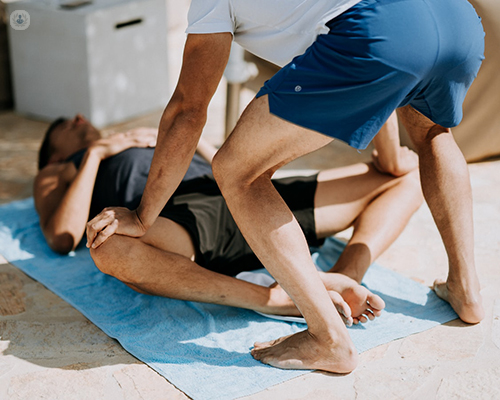Slipped disc: how can it be prevented?
Escrito por:A slipped disc occurs when the soft cushion of tissue between the bones in the spine pushes out. It can happen in a moment of bending, twisting and lifting – especially if you’re making these motions at the same time. In other cases, poor posture is a contributor as is heavy lifting and poor muscle control.
We’ve asked consultant rheumatologist Dr Anthony Hammond for his advice on how to prevent a slipped disc and what the treatment options are if it does unfortunately happen.

Is it possible to prevent a slipped disc?
Yes and no. The disc can just 'go' from bodyweight and with normal or trivial excess use it is not possible to avoid these problems completely if you have been “blessed” with weak discs.
These problems run strongly in families and twin studies have shown a highly heritable component, so there may be nothing you can do to completely avoid issues arising. That said, keeping fit, maintaining posture and abdominal muscle strength can all help.
In short, you should do as gran said: “sit up straight, don’t slouch and walk upright….”
Read more: signs of a trapped nerve you shouldn't ignore
What are the treatment options?
Disc problems and sciatica (a compressed nerve) are very treatable but frequently badly managed. Usually, a brief spell of rest of two days might be needed with pain killers to help relieve the worst of it. Then physiotherapy is accessed.
Many episodes will settle with this but if they do not or if the pain is severe or if there is weakness or numbness then specialist help should be sought early. An MRI scan will usually be taken.
In my practice, sciatica can readily be treated by targeted steroid injections to the affected nerve root called transforaminal epidural steroid injection. These are evidence-based and proven techniques for the rapid control of pain, while nature takes its course.
Many patients will need no more than one or two injections. If this does not settle things then I can perform an endoscopic discectomy. This is the equivalent of conventional open surgical “micro” discectomy but performed through a 1cm skin incision without opening the spinal canal using a medical scope. It can be performed as a day case and recovery from the operation takes only a few days.
What about a partially slipped disc – what are my treatment options?
Finally, the most difficult and most neglected issue is mixed back pain and sciatica due to a bulging but not fully slipped disc. There is no conventional surgery for this, MRI scans are frequently under-reported and patents may be left to suffer long-term.
I have a day case minor operative procedure to reduce the bulge by decompressing from the middle of the disc and heat sealing the back wall called DISC-FX. The procedure is routinely effective in reducing or abolishing disc-related back pain even after decades of trouble.
Do not hesitate to book an appointment with Dr Hammond if you need to have your back pain checked.


